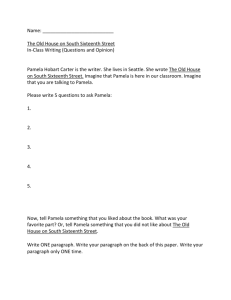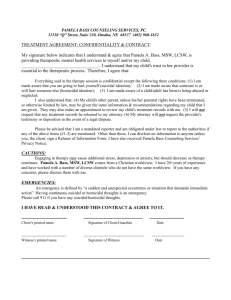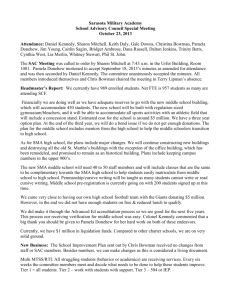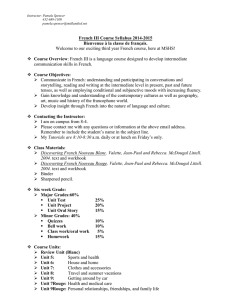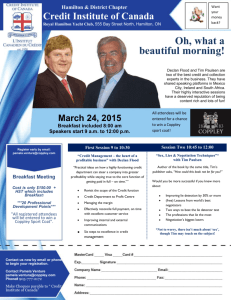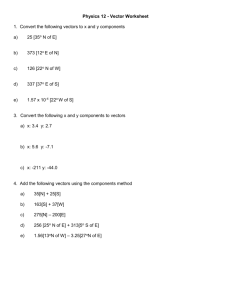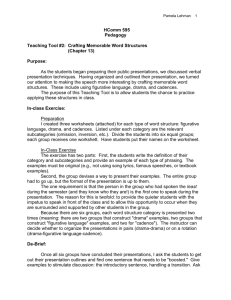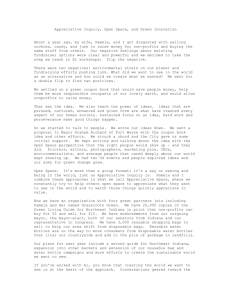What is a Problem
advertisement
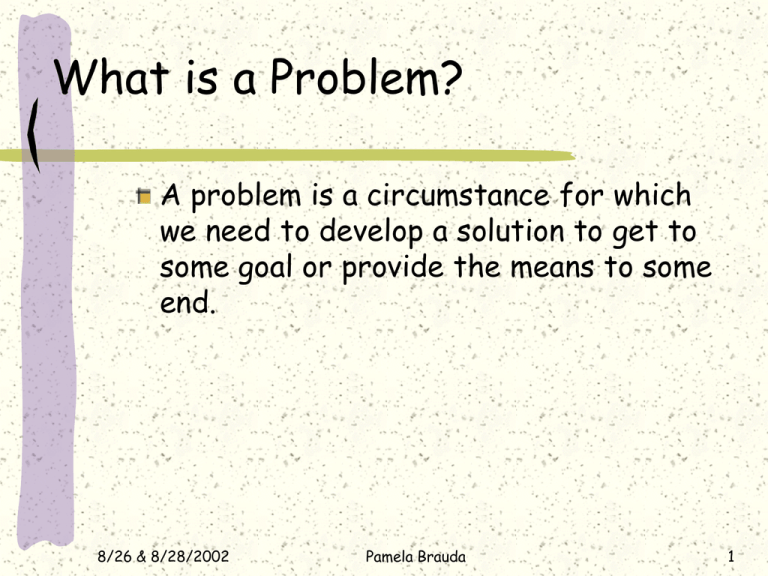
What is a Problem?
A problem is a circumstance for which
we need to develop a solution to get to
some goal or provide the means to some
end.
8/26 & 8/28/2002
Pamela Brauda
1
Types of Problems
Informal Problems
we do NOT necessarily find solutions by
precisely specifying the initial
conditions, the desired results, or the
actions (process) by which we achieve
the desired results
8/26 & 8/28/2002
Pamela Brauda
2
Types of Problems
Formal Problems – the kind that can be
solved by writing a program for a computer
Problems of synthesis: have specific initial
conditions and specific plans of actions
(processes), but specify only the general form
of the result {Trip: Jax, drive, West Coast}
Problems of analysis: the initial conditions and
results are known, but not a specific plan of
action (process) {Trip: Jax, L.A.}
8/26 & 8/28/2002
Pamela Brauda
3
Types of Problems
***All problems solved with the aid
of computers are problems of
synthesis
***The programmer transforms the
problem from one of analysis to one
of synthesis
8/26 & 8/28/2002
Pamela Brauda
4
Solving a Problem
1. Understand the problem
2. Devise a plan – major steps to
accomplish our goal
Divide the problem into segments
Design a solution
Consider alternatives and refine solution
8/26 & 8/28/2002
Pamela Brauda
5
Solving a Problem
3. Carry out the plan (implement)
4. Look back
Did you really solve the problem? If not,
return to Step 1
8/26 & 8/28/2002
Pamela Brauda
6
7 Steps in Program Development
Define the problem
Use a Defining Diagram
Inputs
Outputs
Processing steps to produce the required
output
8/26 & 8/28/2002
Pamela Brauda
7
7 Steps in Program Development
Outline the solution
Break the problem up into smaller steps
Major processing steps involved
Major subtasks
Major control structures (e.g. repetition loops)
Major variables and record structures
Mainline Logic
Use a hierarchy or structure chart
8/26 & 8/28/2002
Pamela Brauda
8
7 Steps in Program Development
Develop the outline into an algorithm
An algorithm is a set of precise steps
that describe exactly the tasks to be
performed and the order in which they
are to be carried out
Think ‘recipe for making French toast as
given to a robot cook’
Pseudocode is how we represent
algorithms
8/26 & 8/28/2002
Pamela Brauda
9
7 Steps in Program Development
Test the algorithm for correctness
Desk checking to identify logic errors
Walk through each step of the algorithm
Keep track of all major variables
Use sample data that tests boundary
conditions
8/26 & 8/28/2002
Pamela Brauda
10
7 Steps in Program Development
Code the algorithm into a specific
programming language
NEVER approach the keyboard without a
plan
Code-as-you-go results in wasted time
and effort
8/26 & 8/28/2002
Pamela Brauda
11
7 Steps in Program Development
Run the program with test data
Syntax errors show up at compile time
Typos, punctuation, grammar
Logic errors appear at run time
2 + 3 = 6???
Sometimes undetected if testing isn’t thorough
8/26 & 8/28/2002
Pamela Brauda
12
7 Steps in Program Development
Document and maintain the program
External documentation
Hierarchy or structure charts, pseudocode, test
data and sample results
Internal documentation
‘Flower Boxes’ at the beginning of each module
or function
Inline comments describing the variables and
what should be happening
Sample program following COBOL Standards
8/26 & 8/28/2002
Pamela Brauda
13
Structured Programming
Top-down Development
Start out with a general solution
Break down the solution into more
detailed steps (modules)
Step-wise refinement – moving from
general to specific
8/26 & 8/28/2002
Pamela Brauda
14
Structured Programming
Modular Design
Group similar tasks together
Reading a file, checking for end of file, verifying the item
read is valid
Printing page headings or totals
Enables several people to work as a team, with
each person working on a separate function
Input/Output
Sorting, Updating
Calculating
8/26 & 8/28/2002
Pamela Brauda
15
Structured Programming
The Structure Theorem
Eliminated the GOTO statement
All programs can be written with 3 basic
control structures
Sequence
Selection, or IF-THEN-ELSE
Repetition, or DO-WHILE
8/26 & 8/28/2002
Pamela Brauda
16
Algorithm to add two numbers
Calculator
Computer
Turn on
Press 1st number
Press ‘+’
Press 2nd number
Press ‘=‘
8/26 & 8/28/2002
Input 1st number
Input 2nd number
Add
Print result (sum)
Pamela Brauda
17
Pseudocode
Structured English used to express
an algorithm
Use indentation for logical flow
One instruction per line
Six basic algorithm structures –
roughly matching the six basic
computer operations
8/26 & 8/28/2002
Pamela Brauda
18
Pseudocode
Getting data into the computer
Read student name {from a file}
Get system date {from the system}
Read number_1, number_2 {file}
Get tax_code {from the keyboard}
8/26 & 8/28/2002
Pamela Brauda
19
Pseudocode
Getting results from the computer
Print ‘Program Completed’ {printer}
Write customer record to file {disk}
Display ‘End of Data’ {screen}
8/26 & 8/28/2002
Pamela Brauda
20
Pseudocode
Doing the math
Add number to total
total = total + number
Compute C = (F – 32) * 5/9
Symbols okay to use: +, -, *, /, (, )
8/26 & 8/28/2002
Pamela Brauda
21
Pseudocode
Assigning a value to a variable
Set Count to 0
Initialize Totals to zero
Total = cost + tax
8/26 & 8/28/2002
Pamela Brauda
22
Pseudocode
Comparing two variables
If-Then-Else
IF Student is part-time THEN
Add 1 to part-time count
ELSE
Add 1 to full-time count
ENDIF
8/26 & 8/28/2002
Pamela Brauda
23
Pseudocode
Repeat a group of actions: DOWHILE, FOR Loop, DO Loop
WHILE student_total < 50 DO
Read student record
Print student name, address to report
Add 1 to student_total
ENDWHILE
8/26 & 8/28/2002
Pamela Brauda
24
Developing an algorithm
Define the problem
INPUT
Processing
Number_1
Number_2
Number_3
Read 3 numbers
Total
Add numbers
together
Print total number
8/26 & 8/28/2002
Pamela Brauda
OUTPUT
25
